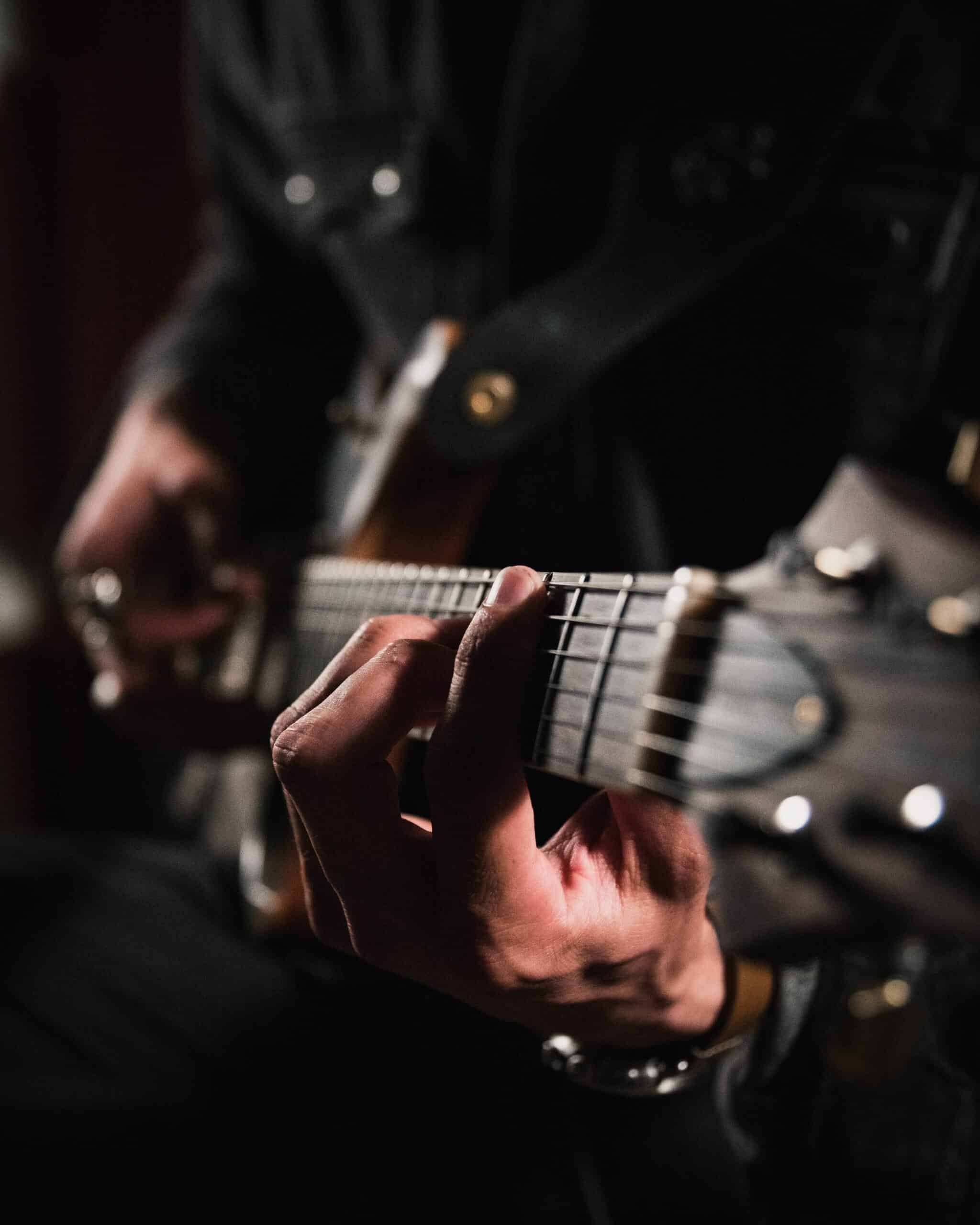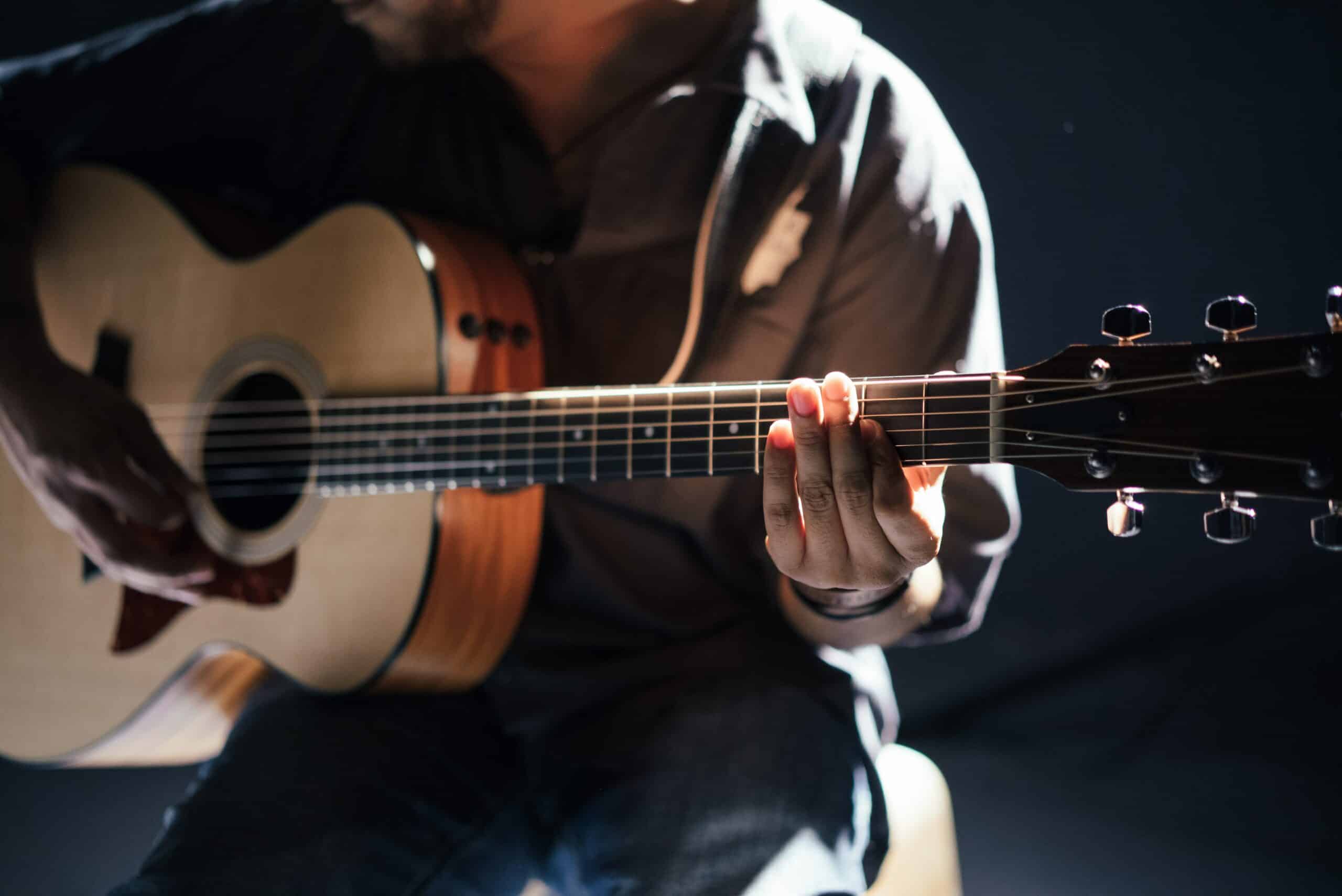It is common for guitar players to experience some kind of thumb of wrist pain when playing guitar. If you have had these discomforts while playing, there are a few things that I recommend you can do that have worked for me!
A lot of times this pain can be avoided from the start and even prevented. You need to pay very close attention to what your left hand is doing and adjust as needed.
Playing Guitar Can Hurt

When you first start playing you’ll find that your fingertips are constantly sore. Then you develop calluses and that pain goes away. Next up is soreness in your thumb and your wrist. Then you make some adjustments and all seems well.
And just when you think you’re past all of the soreness, you learn barre chords and start the process over!
You might not have thought about this, but playing guitar isn’t natural for your hand. It’s a completely new concept so you have to build your muscles and dexterity. I alway tell new guitar players that they’re using the muscles in their hands they’ve never had to use before.
Because of this newness you’ll experience some growing pains.
But there are a few things you can do before, during, and after you play guitar to make sure your hand and wrist are in good shape!
Practice Guitar Little By Little
“Rome wasn’t built in a day” is a saying that people use when they’re emphasizing patience. Something more along the lines of “John Mayer didn’t become an incredible guitarist overnight” seems more fitting.
When you first start to play guitar you want to learn as much as you can, as quick as you can. But guitar is a journey, not a race.
A lot of the journey is based around building the muscles in your hand to physically do the things you need to on guitar. Much of the pain and discomfort guitarists feel comes from building the muscles and flexibility.
If you’re experiencing joint pain as opposed to muscle pain, this can be more serious. This is referred to as negative pain, and should be avoided. Don’t power through this kind of pain!
The best thing you can do is practice a little at a time. Like 5 minute intervals. After about 5 minutes take a break for a couple minutes. After a while your 5 minutes will turn into 10, 10 minutes will turn into 20, and so on.
Just make sure you take a small break once your hand or wrist start to hurt.
Get A Clear Mental Image

The first thing you should do is make sure you have proper hand positioning. Check out my post all about The Best Thumb Position On Guitar.
Once you know what to do, watch your left hand closely. Then watch what my left hand is doing in the lesson videos. While everyone’s exact positioning is going to be different from person to person, it’s a good guiding reference.
If you checked out that article I just mentioned (if you haven’t, check it out and come back!) you should have a pretty good idea of how your hand, thumb, and wrist should be positioned. Now watch it as you play. Are you making enough adjustments as you go? Are you accidentally putting it in a bad position as you go?
You can also film your hand while you practice. This can be pretty revealing!
Identify Pain Source & Relax
There’s a good chance that if you’re having any pain it’s coming from something specifically. Is there a certain exercise, or chord, that’s giving you pain?
Once you find the cause you can isolate it and work on it separately. For example, if you’re trying to play part of a melody that’s tricky you can slow it way down. Isolate just that tricky part and work on it.
After about 5 minutes take a break. Shake out your hand if you need to, work on something else for 5 minutes, and come back to it.
If it’s a barre chord causing pain you can work on partial barre chords instead. The trick is to find whatever that pain trigger is, isolate it, and work on it little by little.
The point you want to get to is to have a relaxed hand (and body) when you’re playing. Even when you’re working on something difficult. This might be the hardest thing to learn on guitar!
We naturally want to tense when we face something difficult. Be it on guitar, a video game, or playing a sport. But being relaxed both in body and mind will help you tremendously.
Listen to Your Body

If your hand is telling you it’s done for now, listen to it. Taking breaks is great for your hand and mind. “Pushing through the pain” isn’t going to work here. You might find yourself making negative progress if you try this.
So when you hit a wall, walk away. Take a 15 minute break, or come back in a couple hours. I think 5 minute intervals a few times a day can be way more powerful than a big 30 minute session.
Breaks are good for your mind too. There are numerous studies that have shown how powerful rests are for retaining what you learned.
Try this: When you’re working on something hard, say a melody, try to play it really slow right before you go to bed. As slow as you need to to play it through. It doesn’t matter if it’s on time. Just make sure you’re playing the right notes.
The next day try to play it again. You should be able to play that part better than the previous day. Just by making that thoughtful move the night before. Your mind is powerful, and it’s also finicky. It needs rest as much (or more) than your body.
Stretch Your Fingers and Thumb
Stretching before (and after) you play guitar is the most underrated and overlooked advice. Think about it: you stretch before going for a run. You stretch before lifting weights. So why not stretch before playing guitar?
Stretching is a critical preventative measure to future joint pain. This is especially important if you have a job that keeps you at a computer much of the day.
Like I said earlier, playing guitar isn’t exactly ergonomic for your wrist and hand. You’re putting them in positions that they weren’t really designed to be in. Properly stretching and warming up can significantly mitigate any long term negative impacts to your joints.
There are a variety of stretches you can do. I personally like to do two different wrist stretches.
Finger Steeple Stretch

This first stretch is one that works on both wrists at the same time.
- Put your palms together in a prayer pose. Then keeping your elbows in place, push the base of your hands down towards the ground until you feel a good stretch. Hold for about 10 seconds.
- Then bring your hands back up in the pose, point your fingers away from your, and bring the base of your hand towards your chest. Hold for about 10 seconds.
- After doing each 3-4 times, do the first stretch but hold for 20 or 30 seconds.
Thumb Stretch
This one is designed specifically for your thumb.
- Grab your left thumb with your right hand.
- Pull it down into your wrist (as far as you can go without causing pain). Hold for a few seconds and switch to the next hand.
Bonus Wrist Stretch #1
- Start by putting your left arm straight out, with your palm facing the ground.
- With your right hand, gently pull your four fingers (minus the thumb) towards your face. Your fingers should be pointing up, or closer towards you depending on your flexibility.
- Don’t pull too hard! Go just until you feel a nice stretch. Hold this for about 30 seconds and then do your other hand.
Bonus Wrist Stretch #2
- Again start by putting your left arm straight out, with your palm facing the ground.
- Instead of pulling your fingers up towards you, take your right hand and press down on your knuckles/the back of your hand so your palm is facing you, and your fingers are pointing to the ground.
- An optional step is to rotate your elbow in towards your body for a nice stretch of your arm.
- Hold for about 30 seconds and move to the other arm.
As you probably realize by now getting the proper thumb position from the start is super important. I've created a dedicated post on this subject at What is the Best Guitar Thumb Position?




Thank you Tomas for your video, something that I was looking for. I'm an absolutely beginner of the 5 string Deering Banjo. The pain that I experience is in my left thumb. The right hand is fine . I'm 80 yrs young/old really, fingers/thumb pain is to be expected. I also have Dupuytren Contracture in my left hand pinky, but is manageable as a beginner so far. I had surgery on my right Ring Finger about three years ago, which really didn't work and a second surgery on the same ring finger was cancelled because of COVID-19, on the Banjo this is fine as the ring+pinky fingers rests down on the head. I play with T-I-M fingers. My left thumb pain started just 4 years ago. I tend to practice between 30-60 mins stretch. I will follow your stretching exercises which really makes a lot of sense, similar to when a person is running , biking or doing any kind of exercising. Once again, thank you for your video and your advice to all guitarists who experience this kind of pain. Stay safe.
Hi Tomas
In the your video Left thumb hurts… pain in your hand, you talk about stretching. I have been doing them very "seriously" for a long time maybe too seriously. That's where I felt that I overdid it. Today I decid to take the "Indian prayers" and "the thumb stretching", you got from a martial sport, if I remember wel. I will start with only these one's and do them with measure.
Thank you for thinking of us older lifelong guitarist who, as in my case face the prospect of limited performance due to left hand thumb pain and similar in right hand first finger. I am told I have no arthritis as seen in blood tests. Thus it could be strain from over use. Ii will try you exercises.